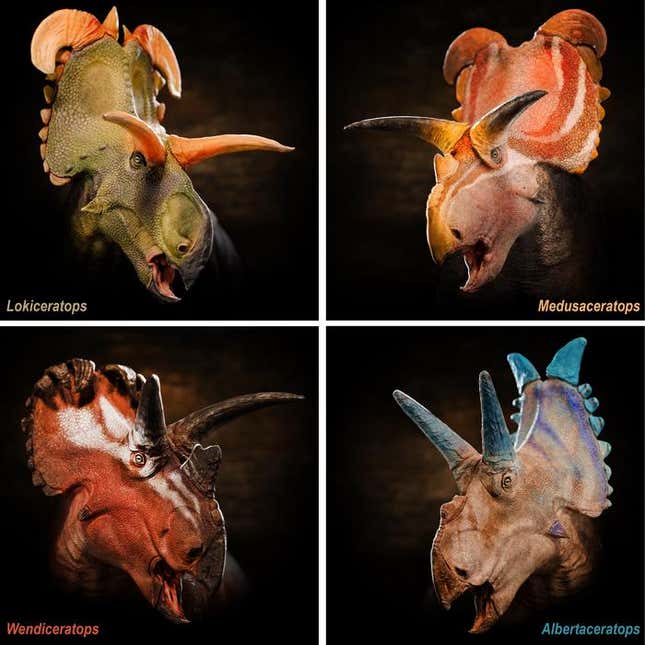Scientists have discovered a new, very cool-looking dinosaur. The intricately horned beast is a relative of the famous Triceratops and has been named Lokiceratops rangiformis. It’s thought to have roamed around the western half of North America over 78 million years ago, back when the continent was split into several large island masses.
Suggested Reading
Suggested Reading
The discovery and naming of L. rangiformis was made by a large group of researchers from the U.S., Canada, UK, Denmark, and Panama. The fossils used to determine its identity were excavated from the badlands of northern Montana, not too far from Canada. Back then, the area was thought to have primarily been swamps and floodplains. And L. rangiformis is thought to have made its home along the eastern shores of Laramidia—an island continent during the Late Cretaceous period that existed as a result of the Western Interior Seaway splitting what we now call North America into two.
Advertisement
The dinosaur’s first name refers to the Norse God Loki, known for his horned attire, while the second is a nod to caribou, present-day animals that tend to have asymmetric antlers. Put the two together and L. rangiformis literally means: “Loki’s horned face that looks like a caribou.”
Advertisement
L. rangiformis is part of a diverse group of dinosaurs known as ceratopsids, which are thought to have first emerged around 92 million years ago. Ceratopsids were successful as a whole, with members living all the way up until the end of the dinosaur age 66 million years ago (when, you know…). But scientists believe that L. rangiformis belonged to a much more narrow niche of these dinosaurs.
Advertisement

The team’s discovery was detailed in a paper published Thursday in the journal PeerJ, while the Natural History Museum of Utah and other affiliated institutions are unveiling the dinosaur to the public this week. The team has also made available beautiful reconstructions of these dinosaurs and three other ceratopsian species that lived alongside it.
Advertisement
“This new dinosaur pushes the envelope on bizarre ceratopsian headgear, sporting the largest frill horns ever seen in a ceratopsian,” said co-lead author Joseph Sertich, a paleontologist with the Smithsonian Tropical Research Institute and Colorado State University, in a statement released by the University of Utah, which manages the museum.
L. rangiformis is the fourth such ceratopsid and fifth horned dinosaur overall to be identified in the area, which has led paleontologists to reassess the evolutionary branch of these animals. The isolated nature of living in Laramidia may have driven L. rangiformis and other ceratopsids to evolve in drastic ways. Fearsome as the horns might appear to us today, the researchers believe that they were more like ornaments, used to entice females into mating.
Advertisement
“These skull ornaments are one of the keys to unlocking horned dinosaur diversity and demonstrate that evolutionary selection for showy displays contributed to the dizzying richness of Cretaceous ecosystems,” said Sertich.
Services Marketplace – Listings, Bookings & Reviews